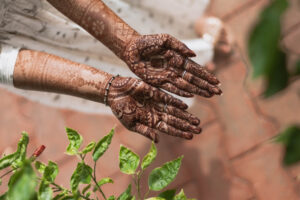
Henna, an ancient tradition spanning continents and cultures, holds a rich tapestry of history, artistry, and symbolism within its delicate leaves and intricate patterns. In this exploration, we delve into the world of henna, from what it is made of to the profound meanings it carries.
What is Henna?
Henna, scientifically known as Lawsonia inermis, is a plant that grows in regions spanning North Africa, the Middle East, and South Asia. The magic of henna lies within its leaves. They are harvested, dried, and ground to create a fine powder, the fundamental ingredient for henna paste.
Then, the powder is mixed with boiled tea water, eucalyptus, or essential oils to form a thick, smooth paste. However, the natural enchantment happens when the paste oxidizes, as it releases lawsone molecules, which stain the skin’s top layer, creating the distinct reddish-brown or orange hue that henna tattoos are renowned for.
What is Henna Art?
Henna art is a profound manifestation of creativity and tradition. It is not merely about adorning the body with beautiful designs; it is a form of storytelling, cultural expression, and personal significance.
Here are some key aspects of henna art:
Cultural Significance:
Henna art carries deep cultural significance in many societies. It is often used during weddings, festivals, and other celebratory occasions. For example, in Indian weddings, the bride’s hands and feet are adorned with intricate henna designs, symbolizing beauty, joy, and the start of a new journey. In the Middle East, henna is a symbol of blessings and protection, often applied to ward off the evil eye.
Symbolism:
Henna designs are more than just aesthetically pleasing patterns. They can carry specific meanings and symbolism. For instance, peacock motifs represent beauty and grace, while paisley patterns symbolize fertility and abundance. The choice of design elements can vary based on the individual’s cultural background and personal beliefs.
Rituals and Rites of Passage:
Henna art is commonly used in rituals and rites of passage. It may be applied during coming-of-age ceremonies, marking significant transitions in a person’s life, such as puberty or pregnancy. These rituals often involve intricate henna designs that hold deep cultural and spiritual significance.
Bridal Henna:
Bridal henna is one of the most elaborate and cherished forms of henna art. It is an integral part of weddings in many cultures, symbolizing love, beauty, and the bride’s transformation into a new chapter of her life. Bridal henna designs are incredibly intricate, often featuring the couple’s initials or symbols representing their love story.
The Meaning of Henna
Henna’s significance transcends its role as a temporary body adornment. Its meanings are multifaceted and deeply rooted in cultural traditions:
- Celebration and Joy: Henna is associated with celebrations and joyous occasions. Its application during weddings, festivals, and other unique events symbolizes happiness, love, and good fortune.
- Protection and Blessings: In many cultures, henna is believed to have protective properties. It is applied to brides and grooms to bring blessings and protect them from negative energies and the evil eye.
- Cultural Identity: Henna designs often reflect a person’s cultural heritage and identity. They may incorporate traditional symbols and motifs that are significant to a particular culture or region.
- Rites of Passage: Henna is used in various rites of passage, marking important transitions in life. It signifies the beginning of a new phase and is believed to bring luck and protection.
- Artistic Expression: Henna is a canvas for artistic expression. Henna artists and enthusiasts use it to create stunning designs, each with its own unique story and symbolism.
Henna is not just a plant-based dye; it is a cultural and artistic phenomenon that continues to captivate and inspire people worldwide. Its significance goes beyond the beauty it imparts to the skin; it is a tangible link to traditions, beliefs, and the shared experiences of countless generations.
Conclusion
Henna, born from the earth and steeped in tradition, has a magical ability to transform the human canvas into a work of art. From its humble origins as a plant to its role as a symbol of celebration, protection, and cultural identity, henna weaves together the threads of history, artistry, and meaning. It serves as a reminder that beauty and tradition are intertwined and that the fleeting beauty of a henna tattoo carries a profound and enduring legacy.